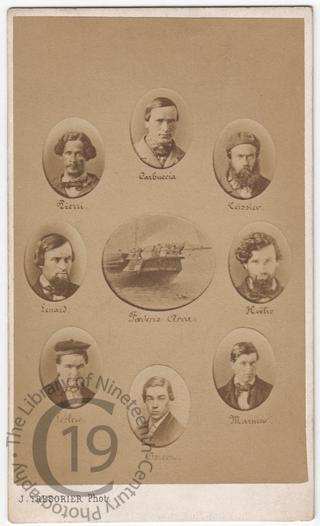
Mutiny aboard the Fœderis Arca
A carte-de-visite showing eight of the mutineers who murdered the captain, the second-in-command and the cook aboard the French merchant ship Fœderis Arca in 1864.
Reports of the exact date vary but sometime towards the end of June or the beginning of July in the summer of 1864, a mutiny broke out in the Atlantic Ocean aboard the Fœderis Arca, a three-masted vessel freighted with liquors and bound for Vera Cruz. According to an account in the Wellington Independent (29 April 1866), the crew later complained that ‘the ship, being undermanned, the hands had more work to do than was expected of them; they were stinted in their food and what little they had was very bad quality.’ A refusal to obey an order soon escalated to violence and the second, M. Aubert, was stabbed to death and his body thrown overboard, soon followed by the cook and the very much still alive captain, M. Richebourg. According to the Times (13 July 1865): ‘notwithstanding his entreaties and expostulations, he also was thrown overboard and perished. A scene of frightful intoxication then took place, the crew making free use of the absinthe, vermouth, &c, found in the ship’s stores.’
After scuttling the ship, the crew departed the scene in two canoes. Amongst them was an eleven-year-old cabin boy, who was on his first sea voyage. Fearing that he might later denounce them, the sailors threw him into the sea and used their oars to prevent him climbing back into one of the boats. Soon after, they were lucky enough to be rescued by a Danish brig and taken to one of the Cape Verde islands.
’The depositions made to the authorities of Brest, drawn up in concert by the conspirators, were to the effect that Captain Richebourg had discovered a leak in his ship, that after having worked the pumps without effect, he had ordered the crew in the boats, himself remaining on board with M. Aubert, the cabin-boy, and the cook; and that the vessel soon after went down with all who remained.’ This account of the ship’s loss was initially believed. However, M. Aubert’s brother noticed inconsistencies in the testimony of the youngest sailor, Chicot, and demanded an investigation. The truth emerged when Chicot, seized with remorse, confessed all to his mother. Warrants were issued and the other men were brought back from the various corners of the world to which they had fled. Tried before a maritime court, four of the crew were sentenced to death and the other four acquitted.
Photographed by Joseph Tresorier of Nantes.
Young Chicot's portrait appears in the medallion at the bottom of the composition. The man at the top, Carbuccia, was, according to some reports, the ringleader.
Code: 126547




